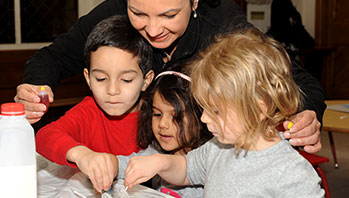- tape or video recorder
- high
- sound
MA Standards:
Speaking and Listening/SL.PK.MA.1: Participate in collaborative conversations with diverse partners during daily routines and play.
MA Draft STE Standards:
Physical Sciences/Matter and Its Interactions/PS4.B: Apply their understanding in their play of how to change volume and pitch of some sounds.
Life Sciences/From Molecules to Organisms/LS1/3.C: Use their sense in their exploration and play to gather information. [Structure and Function]
Head Start Outcomes:
Logic and Reasoning/Reasoning and Problem Solving: Classifies, compares, and contrasts objects, events, and experiences.
Logic and Reasoning/Reasoning and Problem Solving: Recognizes cause and effect relationships.
PreK Guidelines:
Science and Technology/Living Things and Their Environment 15: Use their senses of sight, hearing, touch, smell, and taste to explore their environment using sensory vocabulary.
Small Group: Whose Voice Is It?

© Commonwealth of Massachusetts, Department of Early Education and Care (Jennifer Waddell photographer). All rights reserved.
STEM Key Concepts: Sounds have a source; Sounds vary in three ways: volume, pitch, and timbre
ELA Focus Skills: Speaking and Listening, Vocabulary
Tell children they will continue to explore different sounds heard in voices. Explain that they will play back and talk about the voices they recorded earlier.
- Play the recording of a child saying “I am <age> years old . . .”
- Ask children if they can identify who is speaking. Say, Listen to the voice and try to hear something that helps you identify whose voice it is.
- Ask for example, Does the voice have a high sound? Who in our group has a voice with a high sound?
Then allow children to take turns recording themselves saying “Good morning. I would like to <read> at school today.”
- Play back the recordings one at a time and ask questions such as, What words will you use to describe the sound of the voice? Do you know whose voice this is? What sounds did you hear in the voice that gave you a clue to whose voice it is? How is her voice different from Karla’s voice?
- Continue asking questions to guide children to identify different features of each voice.
Take It Further: You may want to record and introduce other voices into the exploration, such as voices of staff members of the facility, or voices of children’s parents (which you could record when children are picked up the day or week before). Continue to ask children if they recognize the person’s voice, encouraging children to describe what it is about the sound of the voice that helped them identify its owner.
